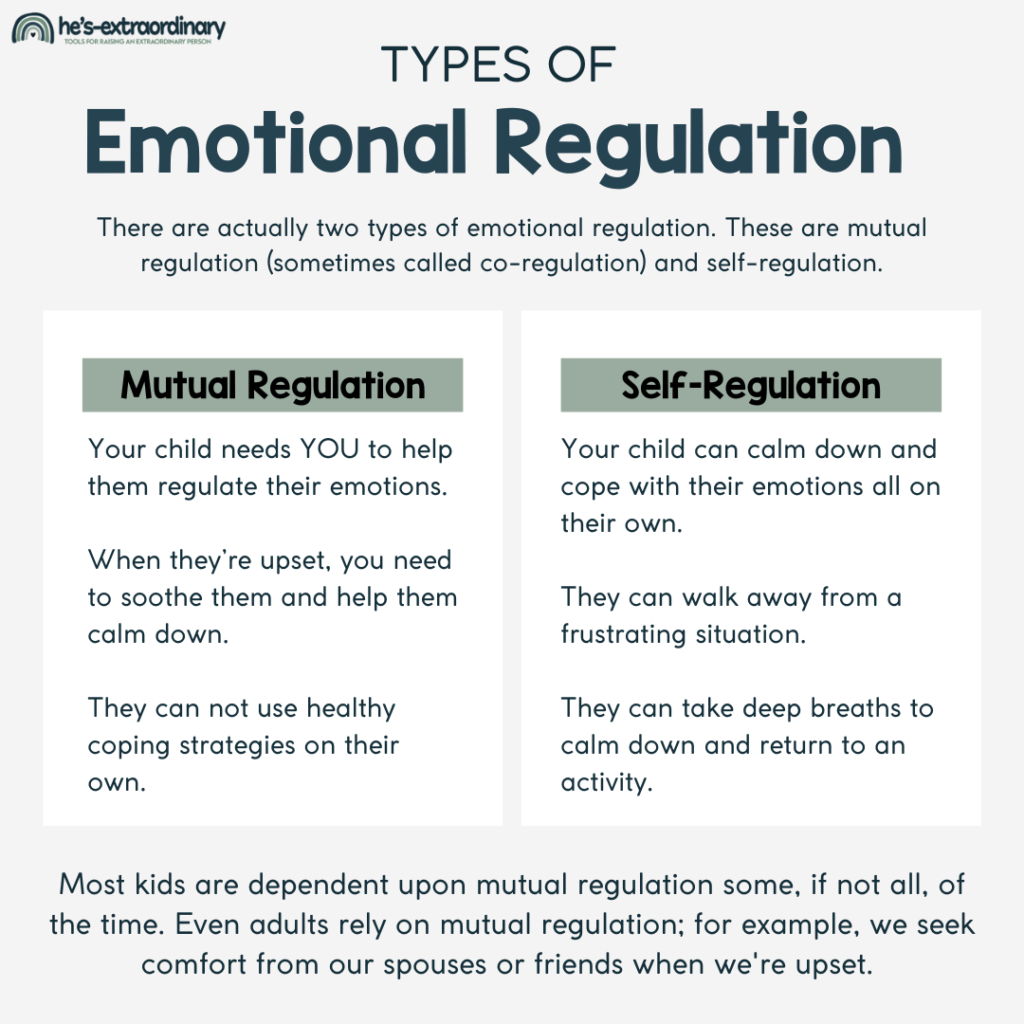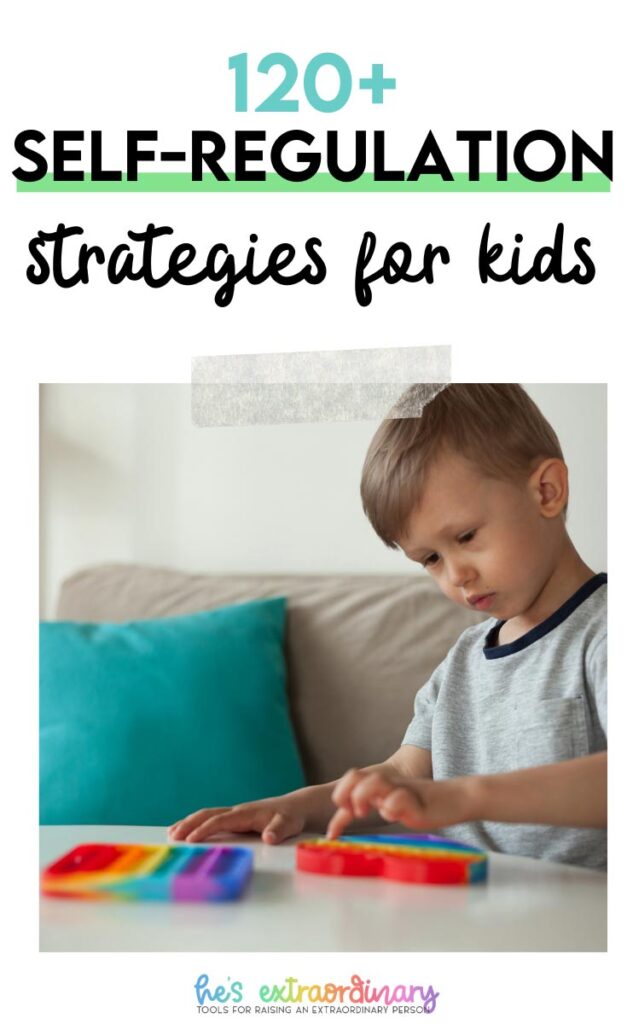120 Emotional Self-Regulation Ideas for Kids
What’s inside this article: A look at different forms of emotional regulation, how to choose strategies that are effective for your child(ren), and a list of 120 emotional regulation ideas to inspire you to find effective techniques.
Disclaimer: This post contains affiliate links.
Emotional dysregulation means that an emotional response does not fall within the conventionally accepted range of emotive responses.
In other words, your kid is literally losing their S*&# because you gave them the wrong color socks today.
Emotional Self-Regulation and Dysregulation
When our kids are not well regulated, they start to “act out,” and you see “behaviors.” Basically, they just don’t have the skills to manage or express their emotions on their own.
Actually, there’s a good chance that they don’t even know what the emotion they’re feeling is. You can’t cope with something that you can’t even label or understand.
But good news! You can teach emotional self-regulation skills. This post contains a ton of strategies to do just that.
Types of Emotional Regulation
There are actually two types of emotional regulation. These are mutual regulation (sometimes called co-regulation) and self-regulation.
Mutual Regulation
Mutual regulation (or co-regulation) means your child needs YOU to help them regulate their emotions. When they’re upset, you need to soothe them and help them calm down. They can not use healthy coping strategies on their own.
Most kids are dependent upon mutual regulation some, if not all, of the time. Even adults rely on mutual regulation; for example, we seek comfort from our spouses or friends when we’re upset.
Does your child come to you when they need help regulating? Or do you need to recognize behavioral cues and be proactive?
Self-Regulation
Self-regulation means your child can calm down and cope with their emotions all on their own. They can walk away from a frustrating situation. They can take deep breaths to calm down and return to an activity.
Your child may even recover from a meltdown on their own.
There’s a developmental trajectory of milestones your child will meet as their self-regulation skills develop.
First will be mutual regulation, with you responding to their cues. Next, they’ll initiate the mutual regulation. Then, some self-regulation skills emerge with you modeling the right strategies.
Over time, as skills develop, your child will start being able to recover from meltdowns sooner, and they will be less intense.

Choosing Emotional Regulation Strategies that Work for You
First, figure out where your child currently sits on the developmental trajectory of emotional self-regulation skills.
You need to know this when you’re picking what strategies are going to work best for you.
There are actually three things you need to consider when you’re deciding which emotional regulation strategies to teach and use.
1. Developmentally Appropriate
First of all, choose strategies that are appropriate for your child’s current level of ability. All kids are unique with their own strengths and weaknesses and unique emotional regulation needs.
2. Functional
You need to choose strategies that are functional. What I mean by this is – your kid needs to be able to use them when they need them during their regular day-to-day routine.
Where does your child spend most of their time? Home, school, the playground? When choosing coping strategies think – will they be able to practice those strategies in these environments when they need to?
3. Align with Family Values
This one is more so for care providers and educators. If you’re teaching or caring for a child with autism or ADHD, you need to make sure that any strategies you teach that child are consistent with the family’s priorities and values.
Parents and educators must work as a team at all times to provide consistency. Having constant communication and an open line to sharing information is the key to success.
Special Contexts
These are just a few other things to think about as you choose emotional regulation strategies that will encourage healthy coping skills for your child.
These are in no particular order but are here to make you think about how your child’s emotional regulation is affected by different scenarios. How is your child affected by the following:
- Group sizes? Large or small
- New environment vs. familiar environment?
- Familiar caregiver vs. unfamiliar caregiver?
- When feeling sick or tired?
- When feeling hungry?
- Can they transition well? Think – how would your child react if they were engaged in a fun activity and suddenly had to stop to sit in their chair for a snack?
Keeping in mind how these different contexts can affect your child, you may choose different strategies and supports depending on the situation.
Emotional Self-Regulation Strategies

Mutual Regulation Strategies
- Play mindfulness games (check out these activity cards)
- Model calm behavior
- Model the self-regulation strategies you want to teach
- Set up opportunities for success
- Use more positive reinforcement
- Have a consistent daily routine
- Have a bedtime routine
- Offer a break
- Offer choices
- Have a break box available
- Remove triggers
- Have a visual schedule
- Offer a snack
- Offer a drink
- Do a movement break – see: 15 fun workouts for kids
- Read a story
- Give a hug
- Match their language
- Get on their level, see the situation from their shoes
- Use these sensory diet cards together
- Use a timer
- Try using a first-then statement
- Give a compliment
- Hold their hand
- Offer a sensory item like a weighted lap pad, or a resistance tunnel
- Diffuse calming essential oils
- Just ask “What would help you right now?”
- Talk about something they like
- Take them for a walk
- Offer solutions
- Remove the audience
- Visualization – Close your eyes and imagine your favorite place
- Ask them to draw you a picture
- Have a reward system for positive behavior
- Squish them – get your child to lie on the floor and squish them by rolling an exercise ball over them.
- Use a massager
- Use a therapy brush
- Talk about feelings and size of the problem
- Use the feelings check-in sheet
- Say, “It makes sense that you feel _____________”
- Say, in a calm voice, “You are safe right now.”
- Create some sensory bins
- Get them to blow pom-poms around the table or through a maze with a straw
- Create a social story
- Talk about upcoming transitions ahead of time
- Rock them calmly
- Wrap them in a weighted blanket
- Turn on the music and have an impromptu dance party
- Ask them to help you with something they’re good at
- Offer to do the task together
- Stop talking or making demands
- Use physical reinforcers like stickers or candy
- Take a Time-In in a calm-down corner
- Use these fun brain break cards (free printable)
Self-Regulation Strategies

- Take deep breaths
- Think of something that makes you laugh
- Go for a walk
- Slowly count backward from 10
- Squeeze a stress ball as hard as you can (Read: Do stress balls actually work?)
- Swing on the swings
- Draw a picture of something that makes you happy
- Write a letter
- Listen to music
- Play with play-doh
- Talk to a grown-up
- Talk to a friend
- Color a picture
- Use positive affirmations
- Make a list of things that you love
- Close your eyes and think about your favorite place
- Read a book
- Rip up paper
- Scream into a pillow
- Do some yoga
- Ask for a hug
- Hug your favorite stuffed animal
- Spend time with a pet
- Watch funny videos
- Identify your emotions
- Write your feelings down
- Tell someone how you’re feeling
- Ask for help
- Hang upside down
- Chew a piece of gum
- Build with Lego
- Bounce on a therapy ball
- Do ten jumping jacks
- Snuggle with your favorite blanket
- Blow bubbles
- Make funny faces in the mirror
- Pop bubble wrap
- Sing your favorite song
- Dance
- Look through a photo album
- Make jewelry with beads and pipe cleaner
- Watch a calm-down bottle
- Watch a lava lamp
- Doodle
- Use a fidget toy
- Go outside
- Turn off the lights and look at something that glows in the dark
- Get some sleep
- Have a healthy snack
- Daydream about the perfect day
- Help someone else
- Watch the clouds
- Jump on a trampoline
- Play with a hula hoop
- Write a love letter to yourself
- Punch your pillow
- Play with a Rubik’s cube
- Keep a comforting object with you
- Use a scratch art doodle pad
- Shake up a snow globe and watch it settle
- Look through a kaleidoscope
- Draw with an etch-a-sketch
- Look at photos of family
- Write in a positivity journal
- Watch your favorite movie
- Do a sticker-by-number art
- Rub your thumb on a chakra worry stone
Remember, these are not strategies to use in succession, nor will these ideas all work with all kids.
These lists are more like a brainstorm of ideas to help you discover new ways to help your child(ren) regulate their emotions.
Take away from this list what is helpful for you and share it to help others.
